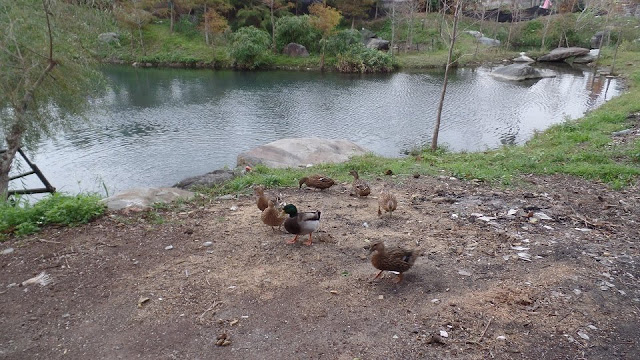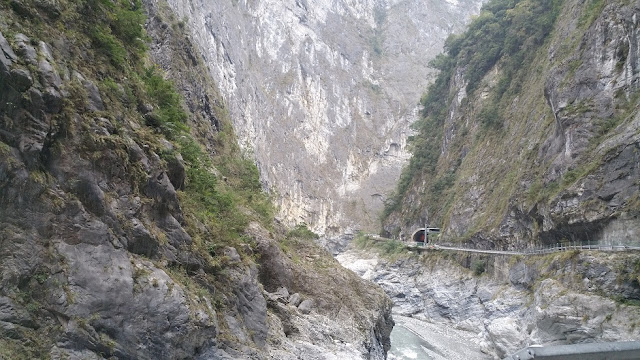We woke up in the morning to find ourselves immersed in a pleasant lush green environment, which we could feel the cool fresh air and hear the birds chirping. Everyone was excited wanting to explore the environment around
Fanlin House (汎水凌山花园民宿), since we did not have that chance when we checked in last night. Before this, we went to the dining area where the hotel staff will prepare the breakfast (toast bread with ham, scrambled egg, soup and hot beverage) for us.
 |
| Fanlin House |
 |
| Our Breakfast |
 |
| Tourist Information Area |
The surrounding garden is well decorated and blends in with the cottage styled buildings, which makes the visitors feel close to the nature.
 |
| Entrance to reception |
There's a pond in front of the garden, with free roaming ducks. The kids were thrilled to see the ducks in close range.
Taroko National Park (太魯閣國家公園)
After the exploration around the hotel, it's time for us to set off to the
Taroko National Park (太魯閣國家公園), the main reason for our visit to Hualien. Taroko National Park (太魯閣國家公園) is a very popular tourist attraction in Taiwan, renowned for its beautiful gorge carved into the marble mountains. It is one of the nine national parks in Taiwan. The word "Taroko" refers to the Truku aborigines (太魯閣族) who lived in the area. From our hotel Fanlin House (汎水凌山花园民宿), it isn't too far away to the entrance of the national park by coach. We stopped by the entrance to take some photos. Over here, it is also the start of the Central Cross-Island Highway (中部橫貫公路), which winds through the gorge uphill towards Lishan (梨山) and then towards Taichung (台中).
 |
| Entrance to Taroko National Park |
 |
| Start point of Central Cross Island Highway |
Taroko National Park Visitor Centre (太魯閣遊客中心)
We made the first stop at the visitor centre, not far away from the park entrance. Over here, we toured the exhibitions that explained about the geography and formation of the Taroko gorge, as well as showcasing the history, way of life and handcrafts of the aborigines who stayed in the area. Specimens of animal, insects and plants local to the region are also on display.
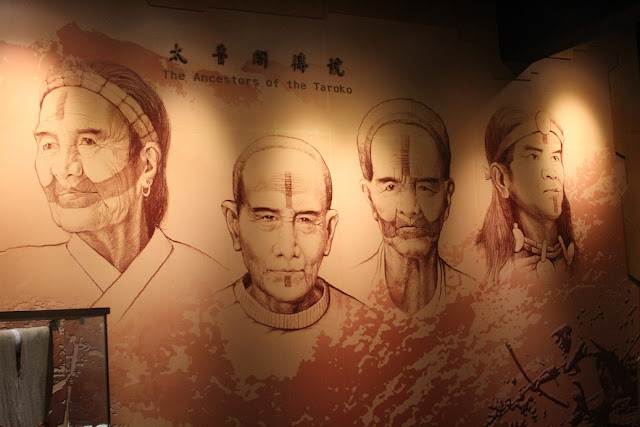 |
| Exhibition on the aborigines living in the Taroko Gorge |
 |
| Handcrafts made of animal bones |
 |
| Typical layout of the aborigines house |
After the exhibitions, we were guided to a multi-media room where an introductory video of the Taroko National Park was screened.
Shakadang Trail (砂卡礑步道)
After the visitor centre having more knowledge about the Taroko gorge, we made our way to the next nearby attraction, the Shakadang Trail (砂卡礑步道). The coach stopped at a red bridge to drop us at the roadside, which the entrance to the trail is located. We have to climb around 4 storey high of metal stairs to the start of the trail.
 |
| Entrance to Shakadang Trail (Source: Photo from alectravelguide) |
 |
| View of the Shakadang River and trail from the bridge |
 |
| Introduction of Shakadang River Valley |
The trail is built along the river cliff and follows along the Shakadang River. The trail is famous for the sapphire blue clear water that visitors could see during the summer season. Unfortunately during our visit, it was winter and the river was relatively dry.
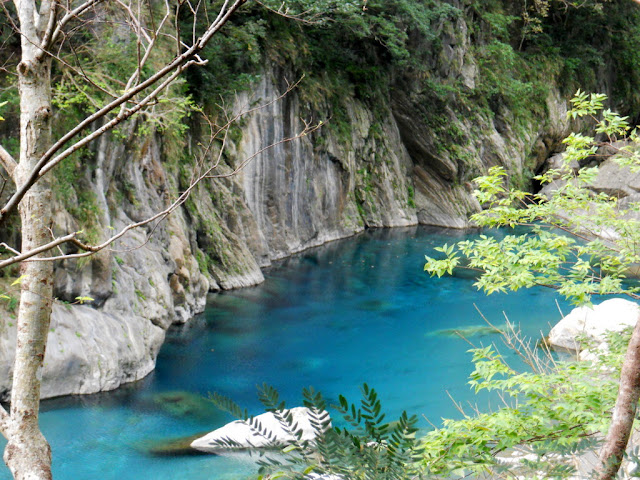 |
| View of Shakadang River during the summer (Source: Photo from sh-bus.com) |
The entire trail is 4.5 km long and ends at the 3D cabin (Sanjianwu 三間屋). We only covered around half of the trail and returned at the 5D cabin (Wujianwu 五間屋), which the overall journey took an hour. At the 5D cabin (Wujianwu 五間屋), there were shops selling beverages and souvenirs. The overall trail is relatively flat and is suitable for children and the elderly to visit.
 |
| View of the red bridge from Shakadang Trail |
Leader Village Taroko (立德布洛灣山月邨)
After the physical walk, the coach brought us to the
Leader Village Taroko (立德布洛灣山月邨) for lunch. Leader Village Taroko (立德布洛灣山月邨) is actually a hotel located at the upper terrace of the Buluowan (布洛灣), which our coach needs to make a series of sharp bends to reach it. Upon reaching the hotel, we find ourselves immerse in the aboriginal ambience, from the decorations to the music played in the background and the aboriginal costumes that the employees wore.
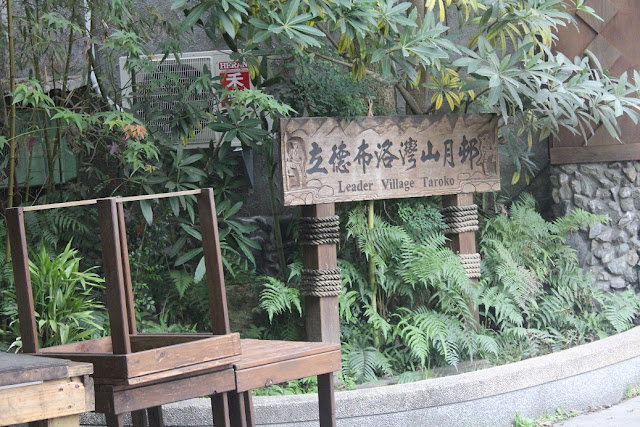 |
| Leader Village Taroko |
 |
| Interior of the restaurant (Source: Photo from mamami.net) |
At the restaurant, they serve aboriginal, Chinese and western fusion specialties, which give customers a refreshing experience. Most of us ordered the set meals, which came with a main (pork, fish, lamb) with sides like salad, baked sweet potato, soup, bamboo rice, dessert and free flow beverage (plum juice, coffee and tea).
 |
| Set meal lunch (Source: Photo from blog.yam.com) |
After the meal, some of us explored around the hotel, which we found ourselves at the open grass patch, surrounded by 37 aboriginal themed cabins.
Buluowan Visitor Centre (布洛灣諮詢中心)
After the delicious aboriginal meal, we decided to stroll down the pathway down to the lower terrace.
 |
| View en-route to the Buluowan Lower Terrace |
 |
| Buluowan Visitor Centre (right) and Handcraft Exhibit (left) |
We paid a visit to the Taroko Handcraft Exhibit (太魯閣工藝展示館), which exhibits the structure and layout of the aborigine houses, tools that they used, and their fabric art.
After the exhibit, we walked further down via the trail, which we could enjoy the view of the gorge.
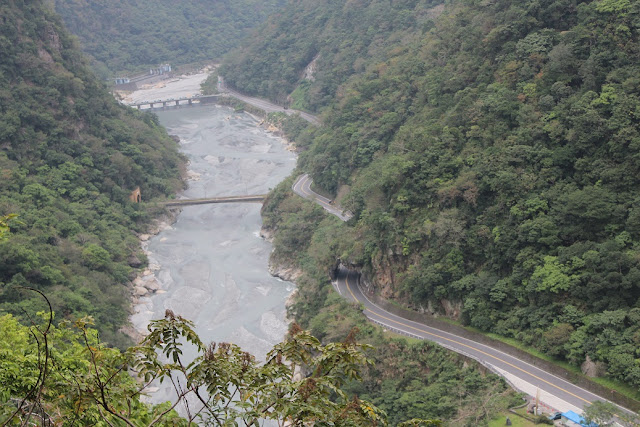 |
| View of the gorge from Buluowan Lower Terrace |
Tianxiang (天祥)
We continued the journey by the coach further upstream to Tianxiang (天祥). Along the way, we passed by other famous sites, such as the Swallow Grotto (燕子口), Tunnel of Nine Turns (九曲洞) and Cimu Bridge (慈母橋).
The terrain at Tianxiang (天祥) is relatively flat, thus we could see several developments here, including the
Silks Palace Taroko Hotel (太魯閣晶英酒店) the only 5 star hotel within the park, youth hostel, restaurants, visitor centre, temple, church and parking space. Over here, it's where the Dasha River (大沙溪) and Taici Jili River (塔次基里溪) meets to form the Liwu River (立霧溪). We strolled past the Plum Garden, then crossed the Zhihui Bridge (稚暉橋) and towards the Pudu Bridge (普渡橋).
 |
| Tianxiang Visitor Centre |
 |
| Plum Garden |
 |
| Zhihui Bridge |
Over here, we enjoyed the scenery and the confluence of the 2 rivers. Beyond the Pudu Bridge (普渡橋) and further up the hill, one could see the pagoda styled Xiangde Temple (祥德寺) and the white robed statue of Guanyin.
 |
| Pudu Bridge |
 |
| Xiangde Temple |
Eternal Spring Shrine (長春祠)
Tianxiang (天祥) was the furthest point we travelled within the park. From here, we turned back and made one last stop at the Eternal Spring Shrine (長春祠) before we bid farewell to Taroko National Park (太魯閣國家公園). The scenic shrine is built over the Changchun Waterfall and serves as a memorial shrine to commemorate the veterans who died while constructing the Central Cross-Island Highway (中部橫貫公路).
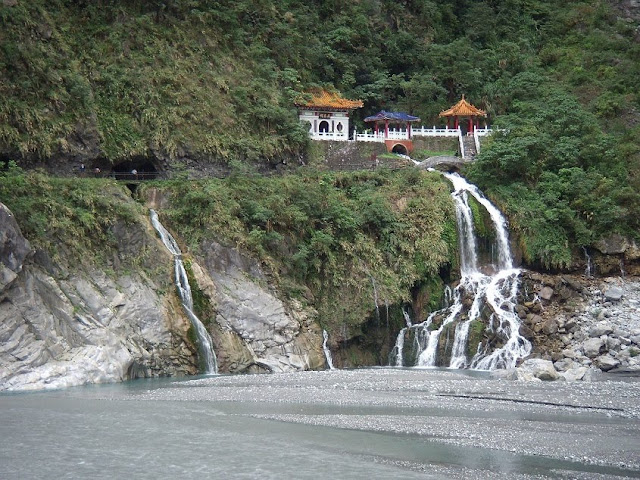 |
| Eternal Spring Shrine |
Hualien Dajili Restaurant (花蓮達基力風味餐廳)
We bid farewell to the beautiful Taroko Gorge and headed to the Hualien Dajili Restaurant (花蓮達基力風味餐廳) for an early dinner, located not far away from the entrance of the Taroko National Park (太魯閣國家公園). The restaurant is run by a Truku aborigine family and they serve authentic aboriginal specialties. It is open concept and decorated with many wooden crafts and furniture.
 |
| Hualien Dajili Restaurant (Source: Photo from walkerland) |
We ordered wild vegetable salad with dragon fruit sauce, roast chicken and pork, sausages, fish and others.
Rainbow Night Market (彩虹夜市)
We returned to Fanlin House (汎水凌山花园民宿) after the dinner, which a small surprise awaited us. Our tour guides had prepared birthday cakes to celebrate for 3 of our tour members who have their birthdays in the month of December. The cakes were simple, but it represents the thoughtfulness of the travel agency, Topology Travel (真程旅行社). As it was still early in the night, a number of us travelled to the Rainbow Night Market (彩虹夜市) located at the city centre, with the help of our driver who was very kind to drive us there. The night market is not very big and was not crowded either. Other than the usual street food and local delights, there are also many game stalls. After the food, drinks and games, we were tired and headed back to the hotel for rest.
 |
| Hualien Rainbow Nightmarket (Source: Photo from travel.network.com.tw) |
Follow the links below to the other days of my Taiwan tour:
Day 1: Taipei (Tamsui, Ximending Hot Pot)
Day 2: Keelung (Tianhou Temple @ Peace Island, Zhong Zheng Park, Ershawan Fortification, Bisha Fishing Port, Nanya Rock Formation, Bitou Cape, Miaokou Night Market, Cashbox Party World)
Day 3: Hualien (Jinan Temple, Nan Fang Ao Fishing Harbour, Qingshui Cliff, Qixintan Beach, Hang Rou, Mochi, Fanlin House Minsu)
Day 4: Hualien (Taroko National Park Visitor Centre, Shakadang Trail, Leader Village Taroko, Buluowan Visitor Centre, Tianxiang, Eternal Spring Shrine, Dajili Restaurant, Rainbow Night Market)
Day 5: Taipei (Yilan Cake Factory, Fu Ge Shi Yao Chicken, Shifen & Sky Lantern, Mei Guan Yuan @ Ximending)
Day 6: Wulai (Neidong National Forest Recreation Area, Wulai Old Street, Sun Moon Light Hot Spring, Ding Tai Fung @ Taipei 101, Chia Te Bakery)
Day 7: Taipei (Hsing Tian Gong, Sun Yat-Sen Memorial Hall, Taipei 101, Wufenpu, Shi Da Night Market)
Day 8 & 9: Taipei (Chiang Kai-Shek Memorial Hall, Shin Yeh Restaurant, National Palace Museum, Shilin Night Market)
























